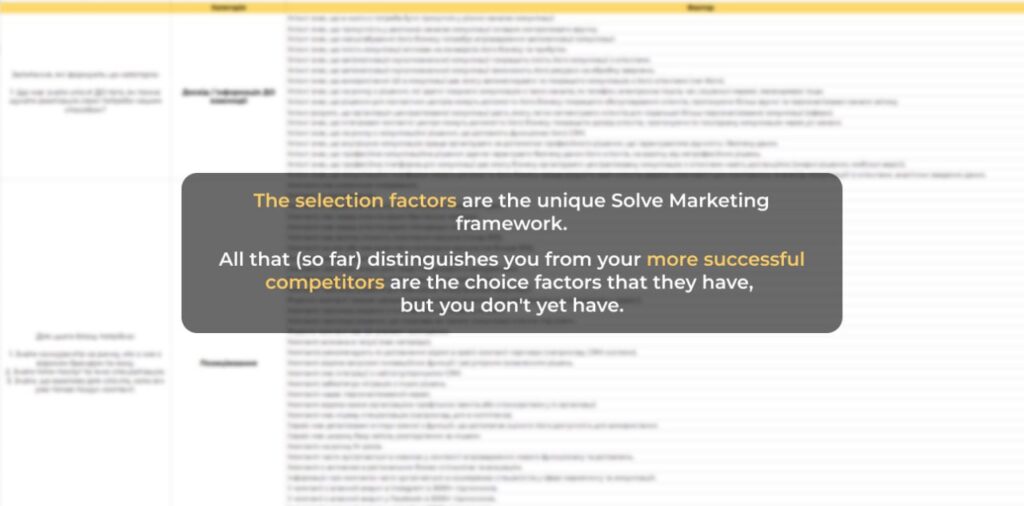Imagine Kyiv in 2023. Air alert, a challenging economy, a crazy amount of change. But at the same time, new chances. While some companies are winding down their business, others are launching projects that are ready for development. But this requires a partner. Someone who understands not only the market, but also the rules of the game – both in business and in the state.
That’s how we got a consulting company that knows how to launch complex turnkey projects. They don’t just look for investors — they create the conditions for an investor to believe, see the potential, and make a contribution to business in Ukraine.
Although the company was made up of experts with 10-15 years of experience, the company was just being formed as a brand. There was no clear positioning, no presence in the information field, no marketing system. Only expertise — deep, strong, but still hidden.
The task we heard:
“We want to create an investment fund in 1-1.5 years. And we need a strategy that will help us show who we are and why we can be trusted.”
This is how our cooperation began.
| How long did it take to develop the strategy? | 200+ hours, 7 working weeks |
| What is the composition of the marketing strategy development team? | Head of Marketing Team, Head of Content Team, Head of PM Team, Operational Marketer, Content Marketer. |
| How was the result of the work used? | Strategy implementation by the client. |
We have signed a non-disclosure agreement (NDA), so the client will remain incognito in this case.
Introduction
A new generation consulting company that works at the intersection of strategic management, investment, public-private partnerships and regional development. Their strength lies in their ability to work with both international investors and local players, adapting complex projects to Ukrainian realities.
The product is not just “consulting”. It is:
- specialised research with access to state statistics;
- project offices for full support;
- work with the GR direction;
- preparation for fundraising and risk management;
- audit of business processes and support in tenders.
The company operates as an investment provider, chosen for its expertise, trust and ability to conduct complex negotiations at the intersection of the government-business-investor interface.
We started with a simple question:
“Is it possible to attract investment in Ukraine now, during the war?”
Even before the full-scale war, there was no rush to invest in Ukraine. Corruption, the judicial system, lack of transparency — all this created doubts that were difficult to dispel even with a very powerful project.
After 24 February 2022, it seemed that the market had come to a standstill. But still… in 2023, people started investing in Ukraine again — cautiously, selectively, but confidently. We looked at every figure, every name in the reports with detective interest. Nestlé, ArcelorMittal, Unilever.
Some invested in production, others repaired what had been destroyed. These were not high-profile marketing campaigns. But they were important signals: the Ukrainian market is alive and this is a chance.
According to the NBU, the volume of foreign direct investment in 2023 grew 7.6 times year-on-year.
But at the same time, investors are not only afraid of losing money, they are afraid of uncertainty. And it was this uncertainty that was most prevalent in Ukraine. The war. Political risks. But at the same time, unrealised potential.
Competition that is not like a competition
As soon as we started diving into the competitive field, it became clear: this is not a classic market where companies compete for a share of traffic and engage in a battle on social media. Everything is more complicated here. And much more interesting.
Yes, many of our competitors have been on the market for a long time, with a strong reputation and cases that speak for themselves.
But our client had something that the others did not — an understanding of the “state machine from the inside“. Their team knew how officials think, how to avoid bureaucratic traps and launch complex projects without unnecessary delays. It was a trump card. But it had to be presented in the right way.
Another piece of the puzzle is interest from other countries. We looked at Google Trends: the query “Invest in Ukraine” increased dramatically in 2022.
| What helps: | What holds back: |
| Government support programs for large investors (benefits, compensations, infrastructure) | War, corruption, judicial system |
| War and political risk insurance (MIGA, DFC) | Lack of reinsurance for war risks |
| Willingness of EBRD, World Bank, IFC to finance large projects | Ukraine is not a signatory to the WTO Investment Facilitation Agreement |
We have investigated where investors’ interest is concentrated:
- Agro processing, pharmaceuticals, energy efficiency, defence.
- IT, transport, engineering, logistics.
- Digitalisation, social infrastructure, reconstruction.
And also military start-ups, medicine, mental health, and demining. Areas that were not even thought of as venture capital attractive before. Now these are new growth points.
A foreign investor is a chess player. He does not make decisions emotionally. He reads reports, monitors changes in legislation, and looks at Ukraine as a risky but promising project. And he needs a local provider who knows the rules of the game.
Most players have been working in this environment for years. Their capital is connections, speeches at forums, mentions in Forbes, participation in the development of government programmes, and cases with billion-dollar deals.
For each of the competitors, we:
- examined positioning, communication, websites, social networks, and media presence;
- identified both strengths and major gaps;
- compiled everything in an interactive comparison table.
We researched the six main players: we carefully studied who and how works at the intersection of investment consulting, legal support, fundraising, and project management.
A foreign investor is a chess player. He does not make decisions emotionally. He reads reports, monitors changes in legislation, and looks at Ukraine as a risky but promising project. And he needs a local provider who knows the rules of the game.
Most players have been working in this environment for years. Their capital is connections, speeches at forums, mentions in Forbes, participation in the development of government programmes, and cases with billion-dollar deals.
For each of the competitors, we:
- examined positioning, communication, websites, social networks, and media presence;
- identified both strengths and major gaps;
- compiled everything in an interactive comparison table.
We researched the six main players: we carefully studied who and how works at the intersection of investment consulting, legal support, fundraising, and project management.
А ще військові стартапи, медицина, ментал хелс, розмінування. Сфери, про які раніше навіть не думали як про венчурно привабливі. Тепер це нові точки росту.
Insight: most competitors lack clear communication with foreign investors. Our client should not compete for the number of years on the market. They should be the voice of intelligent clarity, a modern approach and a confident local provider that speaks the same language as the customer.
Customer engagement tools
In this project, we paid additional attention to engagement tools. Step by step, we studied how the most influential players in the industry work, what channels they use, how they develop personal brands of experts, with whom they cooperate, how they build trust, and, most importantly, why they are trusted.
We classified the tools by effectiveness, goals, effort, and cost. And we made recommendations on the channels that work best for companies which:
- want to attract foreign investment;
- work with the public and private sectors;
- build trust in complex, expensive sales;
- have an expert team that is worth showing publicly.
Insight: you can’t buy trust in b2b with quick advertising — it is built at points of contact, through professional expertise, cases, publicity, partnerships, a personalised approach and a system.
Digital portrait of competitors
Modern business operates not only offline — it lives on Google, talks on LinkedIn, gets to know each other through the website and inspires trust even before a personal meeting.
That’s why analysing the digital presence of competitors is the foundation.
We analysed not only the form but also the substance: logic, communication style, dynamics, intonation, and message structure. This allowed us to understand the role of platforms in the strategy of attracting customers and partners and identify what the market lacks.
Websites: the first touch of expertise
The websites of most competitors are structured, adapted for search engines, multilingual, with a clear positioning and case studies.
Sign up for a free consultation to find out which tools will work for your niche.
However, most of them have the same feature: there is no transparent next step for the user:
- Feedback forms are hidden.
- Calls to action are missing or unclear.
- There are neither offers nor ways to study examples of work.
We also paid attention to the depth of the service pages, the availability of personal team profiles, the publicity of cases, and the frequency of news updates. Some sites had a strong content block, but it was outdated or had not been updated for a long time. This creates the impression that the company is no longer active, even if it continues to operate.
Social media: reputation in real time
Having a presence on social media is a way to shape the way you think about yourself in the eyes of your audience. Companies that are active on LinkedIn and Instagram enhance the sense of live expertise, transparency, and involvement in the process.
We saw a clear division of roles: LinkedIn — to demonstrate expertise, Facebook — for news and communication, Instagram — for the HR brand and informal acquaintance with the team.
However, some competitors have either lost the regularity of content posting or duplicate content from the website without adapting to the social media format. This reduces engagement and turns pages into archives rather than dialogue platforms. In some cases, there is a lack of personal faces of executives, which has long been a must-have in the B2B sphere.
This is not about repeating someone else’s path, but about making your own, more precise and deeper. And we have already laid the foundation for this in the strategic part of the plan.
We will create a strong digital profile that works for you 24/7: a website that converts, content that builds trust, social media that represents you, not just exists.
Your digital profile should work for you. We’ll show you how — come for a consultation.
What really makes a client say “yes”
A potential client doesn’t read all the documents, google the entire history of the company, and definitely doesn’t compare you with all the market players. The decision is often based on one or two choice factors: a friend’s review, a professional website, a relevant case study, a clever interview with the founder, ease of communication, or even… the tone of the manager’s voice.
We have created a unique methodology for analysing and influencing customer decision-making — the choice factors framework. Each consumer is guided by their own set of criteria when choosing goods and services. We have identified the key groups of these factors that determine their final decision:
1. Awareness of possible solutions
A customer can’t choose your offer if they simply don’t know it exists. For example, a person who is unfamiliar with laser vision correction technology will choose between glasses and contact lenses. Your task is not only to present the product, but also to make the client understand that your approach is the best way to solve their problem.
2. Brand positioning and meeting expectations
The way a company presents itself in the marketplace has a direct impact on customer perception. They evaluate whether your mission, values and key characteristics match their own ideas of an ideal product or service. First impressions play a crucial role in further interaction.
3. Quality of interaction experience
At every stage of communication — from the first contact to the conclusion of the deal — a customer forms an opinion about your company. Numerous aspects have an impact:
- speed of response to requests;
- simplicity and comfort of communication;
- clarity and quality of information provided;
- intuitiveness and convenience of processes.
Every detail creates an overall impression that subconsciously influences the decision to cooperate. Your task is to design the customer journey so that it inspires trust, comfort and a desire to work with you.
Your competitive advantage
What makes you different from the companies that have already succeeded in your niche? The answer lies in the choice factors that they effectively use, but that you have not yet implemented. Our goal is to help you identify these critical elements and transform them into your competitive advantage.
To help you consciously influence choice, we’ve compiled 120+ choice factors — the attributes that shape first impressions, build trust and drive action.

You can learn more about the choice factors framework here.
In the future, this becomes the basis for:
- the structure of communication in social networks;
- formation of meanings on the website;
- building personal brands of experts;
- Understanding the barriers and “pains” of customers;
- creating tools for scaling.
Positioning is not about “inventing”, but about “finding”
Positioning is the meaning that the company already has, in its actions, approaches and values. Our task was to see the uniqueness that already exists and formulate it in such a way that it would immediately appeal to those who really need it.
To do this, we conducted interviews and developed separate positioning concepts:
- For the company’s brand.
- And for the team of key experts who are its face.
This made it possible to build a systematic marketing framework where communication is not chaotic but strengthens the brand’s holistic image.
Marketing strategy
The final stage of the marketing strategy is to put all the puzzles together and build a list of specific actions that lead the company to the result.
It’s a logical continuation of the previous steps, turning a brand from a well-packaged idea into a systematic marketing machine.
That is why we have divided the journey into several key stages:
1. Creating brand packaging
- Developing the positioning of the company and experts.
- Creation of a brand book to maintain a unified style of communication.
- Launching the first version of the website and preparing templates for presentation materials.
For this stage, we developed a technical specification for website development.
2. Launching a digital presence
- Design of social media for the company and experts.
- Development and launch of a content strategy for the brand and personal pages.
- Creating email newsletters and building the first subscriber base.
3. Active promotion
- Expanding the website’s functionality and SEO optimisation.
- Active PR activities: interviews, podcasts, forums, communities.
- Launch of educational events and consultations for Ukrainian businesses.
- Content marketing: analytics, blog, external publications.
At the owner’s request, we also developed a content strategy for this stage, calculated the cost of content creation, and described the development of social media for experts.
We also researched the most relevant platforms for placement:
4. Entering the international arena
- International PR: English-language content, articles in the media, webinars.
- Participation in international investment events, pitch sessions.
- Building partnerships with funds, associations, and international companies.
5. Scaling up
- Increasing the amount of content, events and media activity.
- Publishing case studies and building a portfolio.
- Launching special projects with a focus on specific audiences.
- Expanding our presence in other countries, participating in industry ratings and awards.
For this stage, we created a media plan for the first month of the advertising launch:
📌 The entire strategy is built with a focus on integrity:
- each stage reinforces the previous one;
- the brand and experts speak the same language;
- Every point of contact is well thought out;
- Promotion is not “advertising for the sake of advertising”, but in-depth work with trust, expertise and content.
Conclusions
This case is about how a clear system is born out of the chaos of an idea. It’s about how an emerging brand gets a voice that is confident, clear and trustworthy. And how, even in the most difficult conditions, you can build a brand with trust through depth, clarity and consistency.
We immersed ourselves in what is most painful for investors. We created a strategy that combines logic with emotion. Where each block is not just “what to do”, but “why it works for you”.
That’s why a marketing strategy is an ecosystem: it’s alive, dynamic, and built on a deep understanding of goals, challenges, audience, and market.
💬If you are also launching a complex project, entering a new market, or want to test your hypothesis, we are ready to build a system that works for you.





